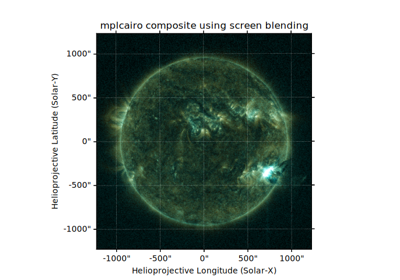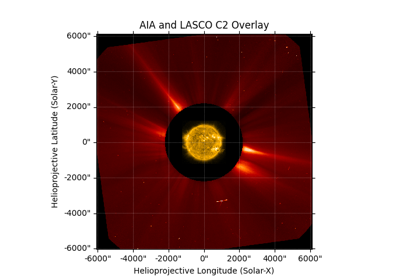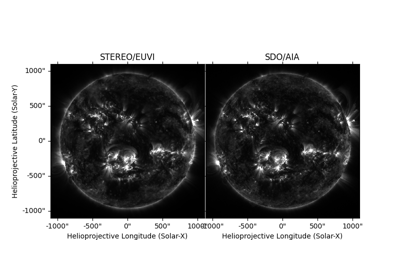Helioprojective#
- class sunpy.coordinates.frames.Helioprojective(*args, **kwargs)[source]#
Bases:
SunPyBaseCoordinateFrameA coordinate or frame in the Helioprojective Cartesian (HPC) system, which is observer-based.
The origin is the location of the observer.
Tx(aka “theta_x”) is the angle relative to the plane containing the Sun-observer line and the Sun’s rotation axis, with positive values in the direction of the Sun’s west limb.Ty(aka “theta_y”) is the angle relative to the Sun’s equatorial plane, with positive values in the direction of the Sun’s north pole.distanceis the Sun-observer distance.
This system is frequently used in a projective form without
distancespecified. For observations looking very close to the center of the Sun, where the small-angle approximation is appropriate,TxandTycan be approximated as Cartesian components.A new instance can be created using the following signatures (note that if supplied,
obstimeandobservermust be keyword arguments):Helioprojective(Tx, Ty, obstime=obstime, observer=observer) Helioprojective(Tx, Ty, distance, obstime=obstime, observer=observer)
- Parameters:
data (
BaseRepresentationorNone) – A representation object orNoneto have no data (or use the coordinate component arguments, see below).Tx (
AngleorQuantity) – The theta_x coordinate for this object. Not needed ifdatais given.Ty (
AngleorQuantity) – The theta_y coordinate for this object. Not needed ifdatais given.distance (
Quantity) – The distance coordinate from the observer for this object. Not needed ifdatais given.observer (
HeliographicStonyhurst, str) – The location of the observer. If a string is provided, it must be a solar system body that can be parsed byget_body_heliographic_stonyhurstat the timeobstime. Defaults to Earth center.rsun (
Quantity) – The radius of the Sun in length units. Used to convert a 2D coordinate (i.e., noradiuscomponent) to a 3D coordinate by assuming that the coordinate is on the surface of the Sun. Defaults to the photospheric radius as defined insunpy.sun.constants.obstime (
tuple,list,str,pandas.Timestamp,pandas.Series,pandas.DatetimeIndex,datetime.datetime,datetime.date,numpy.datetime64,numpy.ndarray,astropy.time.Time) – The time of the observation. This is used to determine the position of solar-system bodies (e.g., the Sun and the Earth) as needed to define the origin and orientation of the frame.representation_type (
BaseRepresentation, str, optional) – A representation class or string name of a representation class. This may change the valid coordinate component arguments from the defaults (see above). For example, passingrepresentation_type='cartesian'will make the frame expect Cartesian coordinate component arguments (typically,x,y, andz).copy (bool, optional) – If
True(default), make copies of the input coordinate arrays.
Examples
>>> from astropy.coordinates import SkyCoord >>> import sunpy.coordinates >>> import astropy.units as u >>> sc = SkyCoord(0*u.deg, 0*u.deg, 5*u.km, ... obstime="2010/01/01T00:00:00", observer="earth", frame="helioprojective") >>> sc <SkyCoord (Helioprojective: obstime=2010-01-01T00:00:00.000, rsun=695700.0 km, observer=<HeliographicStonyhurst Coordinate for 'earth'>): (Tx, Ty, distance) in (arcsec, arcsec, km) (0., 0., 5.)> >>> sc = SkyCoord(0*u.deg, 0*u.deg, ... obstime="2010/01/01T00:00:00", observer="earth", frame="helioprojective") >>> sc <SkyCoord (Helioprojective: obstime=2010-01-01T00:00:00.000, rsun=695700.0 km, observer=<HeliographicStonyhurst Coordinate for 'earth'>): (Tx, Ty) in arcsec (0., 0.)> >>> sc = SkyCoord(CartesianRepresentation(1*u.AU, 1e5*u.km, -2e5*u.km), ... obstime="2011/01/05T00:00:50", observer="earth", frame="helioprojective") >>> sc <SkyCoord (Helioprojective: obstime=2011-01-05T00:00:50.000, rsun=695700.0 km, observer=<HeliographicStonyhurst Coordinate for 'earth'>): (Tx, Ty, distance) in (arcsec, arcsec, AU) (137.87948623, -275.75878762, 1.00000112)>
Attributes Summary
Angular radius of the Sun as seen by the observer.
Default representation for differential data (e.g., velocity)
Default representation for position data
Mapping for frame-specific component names
Methods Summary
assume_spherical_screen(center[, only_off_disk])Context manager to interpret 2D coordinates as being on the inside of a spherical screen.
is_visible(*[, tolerance])Returns whether the coordinate is on the visible side of the Sun.
make_3d()This method calculates the third coordinate of the Helioprojective frame.
Attributes Documentation
- angular_radius#
Angular radius of the Sun as seen by the observer.
The
rsunframe attribute is the radius of the Sun in length units. The tangent vector from the observer to the edge of the Sun forms a right-angle triangle with the radius of the Sun as the far side and the Sun-observer distance as the hypotenuse. Thus, the sine of the angular radius of the Sun is ratio of these two distances.
- default_differential#
Default representation for differential data (e.g., velocity)
- default_representation#
Default representation for position data
- frame_attributes = {'observer': <sunpy.coordinates.frameattributes.ObserverCoordinateAttribute object>, 'obstime': <sunpy.coordinates.frameattributes.TimeFrameAttributeSunPy object>, 'rsun': <astropy.coordinates.attributes.QuantityAttribute object>}#
- frame_specific_representation_info#
Mapping for frame-specific component names
- name = 'helioprojective'#
- observer = None#
- rsun = <Quantity 695700. km>#
Methods Documentation
- classmethod assume_spherical_screen(center, only_off_disk=False)[source]#
Context manager to interpret 2D coordinates as being on the inside of a spherical screen.
The radius of the screen is the distance between the specified
centerand Sun center. Thiscenterdoes not have to be the same as the observer location for the coordinate frame. If they are the same, then this context manager is equivalent to assuming that the helioprojective “zeta” component is zero.This replaces the default assumption where 2D coordinates are mapped onto the surface of the Sun.
- Parameters:
Examples
>>> import astropy.units as u >>> from sunpy.coordinates import Helioprojective >>> h = Helioprojective(range(7)*u.arcsec*319, [0]*7*u.arcsec, ... observer='earth', obstime='2020-04-08') >>> print(h.make_3d()) <Helioprojective Coordinate (obstime=2020-04-08T00:00:00.000, rsun=695700.0 km, observer=<HeliographicStonyhurst Coordinate for 'earth'>): (Tx, Ty, distance) in (arcsec, arcsec, AU) [( 0., 0., 0.99660825), ( 319., 0., 0.99687244), ( 638., 0., 0.99778472), ( 957., 0., 1.00103285), (1276., 0., nan), (1595., 0., nan), (1914., 0., nan)]>
>>> with Helioprojective.assume_spherical_screen(h.observer): ... print(h.make_3d()) <Helioprojective Coordinate (obstime=2020-04-08T00:00:00.000, rsun=695700.0 km, observer=<HeliographicStonyhurst Coordinate for 'earth'>): (Tx, Ty, distance) in (arcsec, arcsec, AU) [( 0., 0., 1.00125872), ( 319., 0., 1.00125872), ( 638., 0., 1.00125872), ( 957., 0., 1.00125872), (1276., 0., 1.00125872), (1595., 0., 1.00125872), (1914., 0., 1.00125872)]>
>>> with Helioprojective.assume_spherical_screen(h.observer, only_off_disk=True): ... print(h.make_3d()) <Helioprojective Coordinate (obstime=2020-04-08T00:00:00.000, rsun=695700.0 km, observer=<HeliographicStonyhurst Coordinate for 'earth'>): (Tx, Ty, distance) in (arcsec, arcsec, AU) [( 0., 0., 0.99660825), ( 319., 0., 0.99687244), ( 638., 0., 0.99778472), ( 957., 0., 1.00103285), (1276., 0., 1.00125872), (1595., 0., 1.00125872), (1914., 0., 1.00125872)]>
- is_visible(*, tolerance: Unit("m") = <Quantity 1. m>)[source]#
Returns whether the coordinate is on the visible side of the Sun.
A coordinate is visible if it can been seen from the observer (the
observerframe attribute) assuming that the Sun is an opaque sphere with a fixed radius (thersunframe attribute). The visible side of the Sun is always smaller than a full hemisphere.- Parameters:
tolerance (
Quantity) – The depth below the surface of the Sun that should be treated as transparent.
Notes
If the coordinate is 2D, it is automatically deemed visible. A 2D coordinate describes a look direction from the observer, who would simply see whatever is in “front”, and thus cannot correspond to a point hidden from the observer.
The
toleranceparameter accommodates situations where the limitations of numerical precision would falsely conclude that a coordinate is not visible. For example, a coordinate that is expressly created to be on the solar surface may be calculated to be slightly below the surface, and hence not visible if there is no tolerance. However, a consequence of thetoleranceparameter is that a coordinate that is formally on the far side of the Sun but is extremely close to the solar limb can be evaluated as visible. With the defaulttolerancevalue of 1 meter, a coordinate on the surface of the Sun can be up to 11 arcseconds of heliographic longitude past the solar limb and still be evaluated as visible.Examples
>>> import numpy as np >>> import astropy.units as u >>> from astropy.coordinates import SkyCoord >>> from sunpy.coordinates import HeliographicStonyhurst, Helioprojective
>>> hpc_frame = Helioprojective(observer='earth', obstime='2023-08-03')
>>> in_front = SkyCoord(0*u.arcsec, 0*u.arcsec, 0.5*u.AU, frame=hpc_frame) >>> print(in_front.is_visible()) True
>>> behind = SkyCoord(0*u.arcsec, 0*u.arcsec, 1.5*u.AU, frame=hpc_frame) >>> print(behind.is_visible()) False
>>> hgs_array = SkyCoord(np.arange(-180, 180, 60)*u.deg, [0]*6*u.deg, ... frame='heliographic_stonyhurst', obstime='2023-08-03') >>> print(hgs_array) <SkyCoord (HeliographicStonyhurst: obstime=2023-08-03T00:00:00.000, rsun=695700.0 km): (lon, lat) in deg [(-180., 0.), (-120., 0.), ( -60., 0.), ( 0., 0.), ( 60., 0.), ( 120., 0.)]> >>> print(hgs_array.transform_to(hpc_frame).is_visible()) [False False True True True False]
- make_3d()[source]#
This method calculates the third coordinate of the Helioprojective frame. It assumes that the coordinate point is on the surface of the Sun.
If a point in the frame is off limb then NaN will be returned.
- Returns:
new_frame (
Helioprojective) – A new frame instance with all the attributes of the original but now with a third coordinate.





